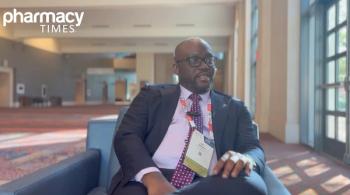
Pharmacists Can Help Patients with Melanoma Monitor Immune-Related Adverse Events When Starting Newly Approved Immunotherapies
Pharmacists have an important role in helping patients to identify treatment-related toxicities and manage symptoms to help the transition to the outpatient setting.
Julia Stevens, PharmD, BCOP, Clinical Pharmacy Specialist - Ambulatory Oncology, Beth Israel Deaconess Medical Center, Boston, Massachusetts, discusses recent developments and patient considerations for 2 recent approved first-line therapies for melanoma at Hematology/Oncology Pharmacy Association (
PT Staff: How do the mechanisms of action (MOA) of the LAG-3–blocking antibody relatlimab compare to programmed death 1 (PD-1) inhibitor nivoluab for patients with melanoma? (Why are they able to work together synergistically?)
Julia Stevens, PharmD, BCOP: So relatlimab is more similar to ipilimumab in that it's hitting another inhibitory checkpoint on the T-cell, essentially taking off the brakes on one of those other inhibitory signals to T-cell proliferation activation. So, it works with Programmed cell death protein 1 (PD-1) both LAG-3 and PD-1 are often overexpressed in patients who have exhausted T cells in the tumor—they have been overstimulated with all the antigens there. And so, PD-1 and LAG-3 inhibition work together by both taking away and inhibitory signal to the T cell, allowing for T cell proliferation activation.
PT Staff: Can you please discuss the method of action (MOA) of other novel therapies, such as tebentafusp?
Julia Stevens, PharmD, BCOP: Tebentafusp is given kind of 2 different categories; one is a bite. So bispecific T cell engaging antibody or, excuse me, I should start that over again. So tebentafusp is sometimes called a bite therapy. So a bispecific T-cell engager. It's also sometimes called an ImmTAC molecule (immune mobilizing monoclonal T cell receptor against cancer). That is a mouthful. So essentially, tebentafusp does is it has one side with a CD3 (Cluster of differentiation 3) engaging domain, where it can activate T-cell proliferation, and activation on the other side has a domain that recognizes the complex of a specific major histocompatibility complex (MHC) 1 molecule, the HLA-A*0201, when it is expressing or holding a gp100 antigen.
On the one side, we're activating the T cell, on the other side connecting to that HLA-gp100 complex, bringing them together and allowing the T cell to activate and kill that expressing self.
PT Staff: What could the supportive treatment plan using a novel therapy look like?
Julia Stevens, PharmD, BCOP: so I'll start with one drug at a time. Relatlimab, because it's a fixed-dose combination with nivolumab, is going to have a lot of those combined checkpoint blockade considerations that we know of. So it adds additional immune-related side effects. So we need to keep monitoring for the same immune-mediated side effects we do for other therapies; hepatitis nephritis, all of the gastrointestinal (GI) side effects, dermatitis, and all of the host of other things that can come along with that.
Tebentafusp, as a bispecific T-cell engager, has some similar risks similar to other bispecific therapies. Similar to blinatumomab, it has a risk for cytokine release syndrome (CRS) patients actually need to receive their first 3 doses and an escalation scheme in an observation setting where we can treat those patients for CRS. So tebentafusp requires observation in an inpatient setting or observation setting where we can give them hydration, potentially steroids, or vasopressors for really severe CRS events. Once they transition to the ambulatory setting, there's less risk of that CRS and we just need to monitor for them for 30 minutes as opposed to 16 hours after their initial inpatient doses.
Another important thing to think about is the rash. So gp100 Is the antigen we're recognizing, and that's actually also expressed in other dermal tissues. So many, many patients will experience a rash and require antihistamines or topical steroids or even systemic corticosteroids for those really extensive or severe rashes.
PT Staff: How can pharmacy and oncology teams provide support to patients with treatment-related toxicities?
Julia Stevens, PharmD, BCOP: I think pharmacists play a huge role in toxicity, identification and management. Certainly, knowing what the onset I think, is really important. So when we're talking about those immune-related adverse events (AEs) with relatlimab, the onset follows the more delayed onset we would expect for other checkpoint combinations, although certainly patients can present early with these. But it's important for patients to know that if they don't have a side effect with the first cycle, it doesn't mean they're totally out of the woods. And we need to keep that in mind as well. With tebentafusp, the answer to the side effects is almost entirely in the first several doses. And the onset really drops after the first, say, 2 months. So knowing when to look for these side effects is important knowing what to look for. And then obviously, also, prompt treatment of the side effects is really important, with corticosteroids playing a big role in both of these immune therapies.
PT Staff: Do adverse events impact patient medication adherence, even if adverse events are not longstanding?
Julia Stevens, PharmD, BCOP: That's a great question. So I think if we educate patients up front about what to expect, and that things get better with time, that really gives them the courage they need to keep going, especially if they know that we're going to be dedicated to supporting them through those side effects so they can transition to the outpatient setting and really proceed after the first several doses without too many issues.
PT Staff: How can pharmacy teams help to increase the number of patients who can access these new therapies?
Julia Stevens, PharmD, BCOP: So these novel therapies are both intravenous (IV). And so I think pharmacists play a role here and evaluating these drugs for formulary, educating team members about the appropriate use and management of these drugs—both our physician colleagues, our nursing colleagues, other pharmacist on our teams, who would be cross-covering our patients. And then finally, in access, it's important to think about appropriate insurance approvals and protecting patients from financial toxicity of treatment also. So whatever your role is, there's something you can do to help these patients.
Newsletter
Stay informed on drug updates, treatment guidelines, and pharmacy practice trends—subscribe to Pharmacy Times for weekly clinical insights.


















































































































































































































